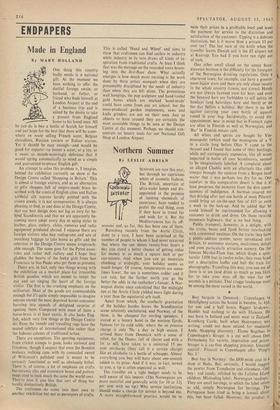ENDPAPERS
Made in England
By MARY HOLLAND
ONE thing this country badly needs is a national gift. At the moment we have nothing to offer the dutiful foreign swain, or husband, or father, or friend who finds himself at London Airport at the end of a business trip and is seized by the desire to take a present from England home to his loved ones. All he can do is buy a bottle of Scotch for himself and just hope for the best that there will be some- where en route selling French scent, Belgian chocolates, Russian caviare or Italian scarves. Yet it should be easy enough—and would be good for exports—to invent a scent, or a toy, or a sweet so mouth-wateringly delicious that it would spring automatically to mind as a simple and guaranteed-to-please English gift.
An attempt to solve this problem is, I imagine, behind the exhibition currently on show at the Design Centre called 'Shopping in Britain.' This• is aimed at foreign visitors, and as an alternative to gifte shoppes full of empire-made brass in- scribed with the crests of English cities and Italian artificial silk scarves luridly printed with the crown jewels, it is not unimpressive. It is always pleasing to find, as one does at the Design Centre, that our best design does not lag so very far be- hind Scandinavia and that we are apparently be- coming more adept every day at aping styles in leather, glass, cutlery, china, cameras and radio equipment produced abroad. I suppose there are foreign visitors who buy radiograms and sets of matching luggage to take home as gifts and the selection at the Design Centre seems irreproach- able enough. The same goes for the Pyrex casse- roles and rather dull cutlery and I hope they gladden the hearts of the lucky girls from San Francisco to Sao Paulo who get them as presents.
There are, in fact, only two things wrong with the exhibition as a market place for irresistible British goodies which are meant to tempt the eye and set singing the heart of the foreign visitor. The first is the crushing emphasis on the utilitarian. Most of the goods are commendable enough but it's quite simply impossible to imagine anyone except the most deprived Soviet consumer bursting into squeals of delighted surprise at opening them. Compared with most of them a horse-brass is at least exotic. It also looks Eng- lish, which very few things at the Design Centre do. Even the tweeds and travelling rugs have the muted subtlety of international chic rather than the hideous colours of traditional tartan.
There are exceptions. The sporting equipment, from cricket stumps to guns, looks national and frivolous, though I suspect that even the Bondish malacca walking cane with its concealed sword of Wilkinson's polished steel is meant to be seriously functional as well as obviously lethal. There is, of course, a lot of emphasis on crafts but ceramic tiles and stoneware boxes and pottery mugs tend to look much the same the world over. They're nice if you like that sort of thing but hardly distinctively British.
The craftsmen do come into their own in another exhibition but not as purveyors of crafts.
This is called 'Hand and Wheel' and aims to show that craftsmen can find outlets in industry while industry in its turn draws all kinds of in- spiration from traditional crafts. At least I think that was the message on the recorded voice boom- ing into the first-floor show. What actually emerges is how much more exciting is the work done by these artists tnanques when they are presumably disciplined by the needs of industry than when they are left alone. The pretentious wall hangings. the pop sculpture and hand-tooled gold boxes which are marked 'hand-made' could have come from any art school, but the mass-produced garden implements, saws and knife grinders are out on their own. Just as objects to have around they are certainly the most covetable things to be seen at the Design Centre at the moment. Perhaps we should con- centrate on luxury tools for our National Gift Shop at London Airport.






























 Previous page
Previous page